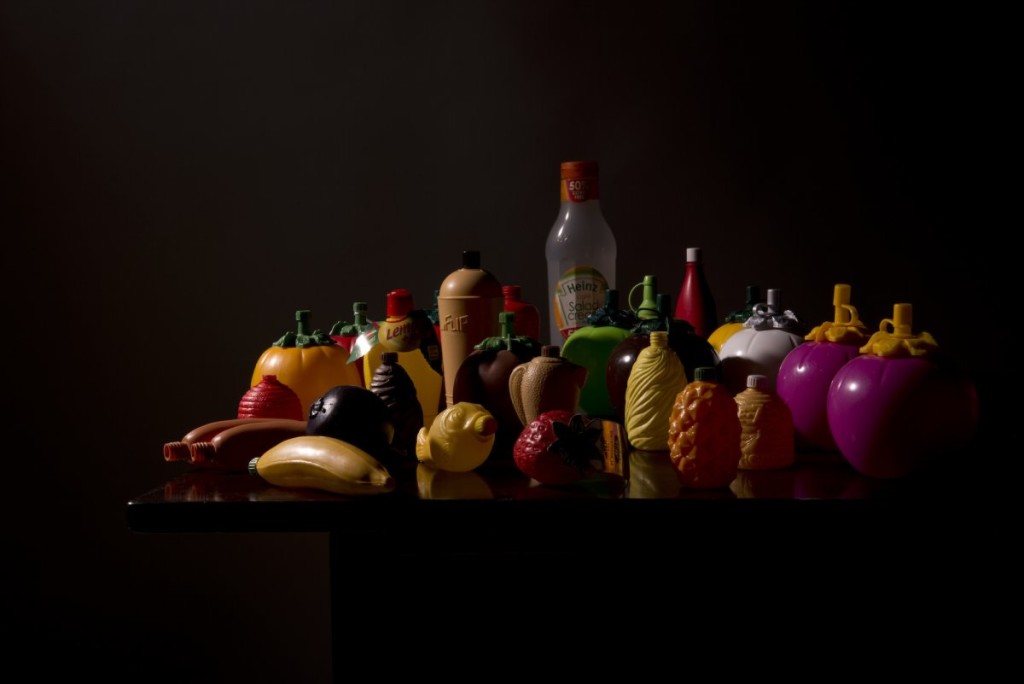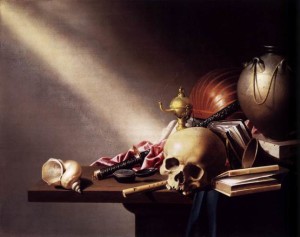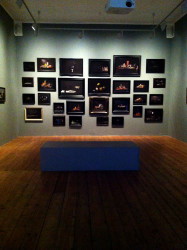
Mariele Neudecker, Still Life with Ketchup Bottle and Lemon [AIBDC, 92, CR, 31, Shelf 7 of 8, 0.8kg], 2015
I have always been an avid biker, for many years bikes were my only form of transport. This meant I had friends and family who were bikers too and we would all hang out together whenever the weather was vaguely accommodating. The trips we would head out on generally involved stopping for food at a roadside café, often the only places that were willing to let us stop however respectable the bikes or their riders.
Surprisingly, this is where I went when I saw Neudecker’s Still Life with Ketchup Bottle and Lemon [AIBDC, 92, CR, 31, Shelf 7 of 8, 0.8kg]. Those once ubiquitous squeezy ketchup bottles that resembled a large stylised tomato. I remember them as being made of quite a hard plastic that was often difficult to squeeze and filled with a distinctly vinegar tasting ketchup. It felt like a reminder of a different age and yet the symbols live on, the exhibition title of Plastic Vanitas seemed very appropriate.
Plastic Vanitas is the result of a residency Neudecker took part in at the Museum of Design in Plastic and the Arts University, Bournemouth. Born in Germany, she has lived and worked in Bristol since 2001. She completed a BA at Goldsmiths, an MA at Chelsea College of Art & design and took a course in digital image creation/ manipulation at Tower Hamlets College. She has been exhibited and published widely as well as lecturing and participating in conferences. I think all aspects of her training and experience are exposed in the images in this exhibition.
The exhibition of 49 images was curated by Prof. Susan Lambert (Head of MoDiP) and consists of photographic works in a range of frames, most of which look traditional and slightly ornate. The Vanitas still life tradition originated in Northern Europe in the late 1520s and was associated with a verse from the Old Testament book of Ecclesiastes (1:2; 12:8): ‘Vanitas vanitatum… et omnia vanitas’, translated ‘vanity of vanities, all is vanity’. Strongly symbolic in nature a Vanitas image contains a range of signs originally informed by early Christianity that highlight the perils of vanity, the transience of life and the inescapability of death.
A vanitas painting tries to convey the essential meaninglessness of earthly goods and pursuits, when compared with the eternal nature of true Christian values. Visual Arts Cork

Vanitas Still Life by Herman Steenwijck, 1640
At its height in the 17th Century in the Netherlands these paintings originally included symbols such as a skull signifying death; books or maps highlighting secular knowledge; fruit and flowers that will inevitably wilt; and jewellery showing wealth and power. Neudecker has taken a more contemporary set of symbols and applied them in such a way that challenges us to examine our individual lives but also to take a macro perspective and contemplate what these images mean in relation to the planet we inhabit.
…The vanitas paradigm shines a new light literally and metaphorically on these mundane objects. Individually they are redefined as contributors to life’s precarious mortality. Carmen curlers are no longer useful beauty aids but instead emblems of vanity; a protective hockey helmet becomes a spectre of what might happen were it not worn; clocks become the harbingers of life’s brevity; and so on. The compositions as a whole act as allegories of the challenges that face our world with its dwindling resources. Prof. Lambert

Neudecker, Plastic Vanitas at Bow Arts, 2016
The low lighting in the gallery meant initially I had to check my glasses as they were still dark from the outside sun. The subdued light, the beauty of the images and the hanging of the work ensured I spent time really observing. As I mentioned earlier my initial response was about spotting those items that were familiar or prompted a memory, ‘when we find a photograph meaningful, we are lending it a past and a future.’ Berger & Mohr, 1982: 89
There was also a slight sense of illusion contained within the images, for a while I was not sure I was really seeing what my brain was telling me I was seeing. I should have been looking at Dutch old masters, traditional still lives, but here were collections of plastic objects.
I was particularly struck by the contradictory notion of transience held within these images. The still lives clearly come from a symbolic tradition that highlight the issue of human vanity and our impermanence as human beings yet many of the objects used are now known to have an almost indefinite shelf life. These plastics will outlive me by generations. They are both meaningful and meaningless, many of them are now regarded as obsolete. Fashion and production techniques have moved on yet the physical presence of these objects highlights how humanity’s vanity and thoughtlessness has created an environmental crisis, the potential for transience on a global scale.
Acknowledgement: I would like to thank Mariele for her permission to feature ‘Still Life with Ketchup Bottle and Lemon’ on my blog
References:
Berger, J., & Mohr, J. (1982). Another way of telling. London: Writers and Readers Publishing Cooperative Society.
http://www.visual-arts-cork.com/definitions/vanitas-painting.htm
http://bowarts.org/sites/default/files/NUNNERY_PlasticVanitas_PR.pdf
http://aub.ac.uk/exhibition/plastic-vanitas/





















